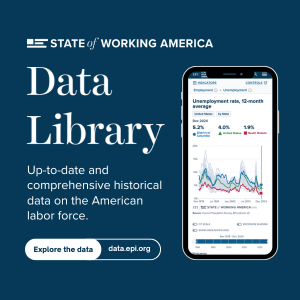What’s UI got to do with it?
Unemployment insurance (UI) benefits in this economic downturn have helped cushion the blow of job loss for millions of families. A case in point: the Census Bureau estimates that 3.2 million people, including nearly a million children, were kept out of poverty by unemployment insurance in 2010 (see slide 25 here). But could the extensions of UI benefits over the last three years have at the same time made the labor market substantially weaker by providing a disincentive for unemployed workers to return to work quickly, as some economists (perhaps most famously here) have claimed?
The answer is a resounding no. In the most careful study to date on the effects of UI extensions on job search in the Great Recession, Jesse Rothstein finds that the unemployment rate in Dec. 2010 would have been about 0.3 percentage points lower if UI benefits hadn’t been extended. The unemployment rate that month was 9.4 percent, up from 5 percent in Dec. 2007, an increase of 4.4 percentage points. Thus, according to Rothstein’s findings, a very small fraction – 0.3 out of 4.4 — of the increase in the unemployment rate during the Great Recession and its aftermath can be attributed to the UI extensions. And a few additional points make the case even clearer:
- Rothstein shows that at least half of the extension-induced increase in the unemployment rate comes from the fact that workers who receive UI are less likely to give up looking for work. Keeping people in the labor force actively seeking work is arguably a good outcome of UI benefits — and could actually increase the share of the long-term unemployed that later finds a job — but it raises the measured unemployment rate. His estimates imply that less than 0.2 percentage points of the 4.4 percentage point increase in the unemployment rate over the Great Recession was due to an extension-induced reduction in the rate at which workers get a new job, which is the disincentive effect policy makers are actually concerned about. Moreover, even that may be a good thing — a small UI-induced increase in the time it takes for an unemployed worker to get a new job is an asset of the UI program to the extent that it affords unemployed workers the needed space to find a new job that matches their skills and experience or keeps individuals and families from making inefficient choices just to put food on the table and pay bills.
- Furthermore, while Rothstein documents a small UI-induced reduction in the rate at which extension-recipients find a new job, that may not translate into a higher unemployment rate, due to what he calls “congestion in the supply side of the labor market.” He is unable to account for it in his paper, but the intuition is straightforward. Job opportunities plummeted in the Great Recession. From the spring of 2009 through the end of 2010, there were at least five unemployed workers per job opening (see Chart 1 here). In fact, there were (and are) fewer job openings than workers receiving extended UI benefits. There are simply not enough jobs to go around, extensions or no. Extensions have likely affected the mix of the unemployed, with a slight shift of jobs from UI-recipients to other job-seekers, as recipients have more room than non-recipients to take time to find a job that matches their and their family’s needs. But given the lack of job openings, it is a significant leap from a small reduction in the rate of job finding for recipients to an increase in the unemployment rate.
- Finally, Rothstein’s paper looks only at the microeconomic effect of UI extensions on job search and reemployment for recipients. It doesn’t say anything about the macroeconomic effect. Spending on UI extensions is an extremely effective mechanism for injecting money into the economy since the long-term unemployed are, almost by definition, strapped for income and very likely to immediately spend their UI benefits. This spending creates demand for goods and services and generates jobs. In 2010, spending on UI benefits for the long-term unemployed was supporting around 620,000 jobs (see Table 1 here). All else equal, these 620,000 jobs lowered the unemployment rate by around 0.4 percentage points, (and all of that reflects new jobs, not workers dropping out of the labor force). Putting the micro- and macro-estimates together, there is no doubt that the extensions of unemployment insurance benefits in recent years have not increased the unemployment rate. There is also no doubt that these benefits have provided a lifeline to laid-off workers and their families during a time when job-finding prospects are brutally weak.
Enjoyed this post?
Sign up for EPI's newsletter so you never miss our research and insights on ways to make the economy work better for everyone.
